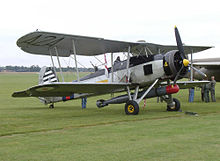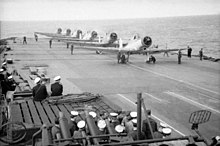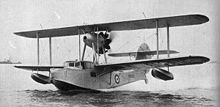
The Fairey Fulmar is a British carrier-borne reconnaissance aircraft/fighter aircraft which was developed and manufactured by aircraft company Fairey Aviation. It was named after the northern fulmar, a seabird native to the British Isles. The Fulmar served with the Royal Navy's Fleet Air Arm (FAA) during the Second World War.

778 Naval Air Squadron was a Naval Air Squadron of the Royal Navy's Fleet Air Arm. During the Second World War the squadron was a Service Trials Unit (STU) initially based at HMS Daedalus, RNAS Lee-on-Solent, Hampshire, England before moving to HMS Condor, RNAS Arbroath, Angus, Scotland on 6 July 1940. The squadron tested all types of aircraft that could be used by the Royal Navy. Key to this was testing new types for deck landing on aircraft carriers. Such aircraft included various types of Supermarine Seafires, Grumman Hellcats, Grumman Martlets, Grumman Avengers, and Vought Corsairs. The squadron was reformed on 5 November 1951 with Douglas Skyraider AEW.1 but was disbanded on 7 July 1952 to form the basis of 849 Naval Air Squadron.
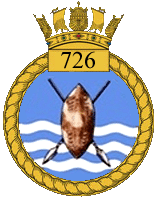
726 Naval Air Squadron was a Naval Air Squadron of the Royal Navy's Fleet Air Arm. It was formed as a Fleet Requirements Unit from 1943 to 1945, operating out of R.N. Air Section Durban, at S.A.A.F. Station Stamford Hill, Durban, South Africa, during its existence. It operated various aircraft including, Bristol Beaufighter, Boulton Paul Defiant, Fairey Fulmar, North American Harvard, Vought Kingfisher, Miles Martinet and Fairey Swordfish.
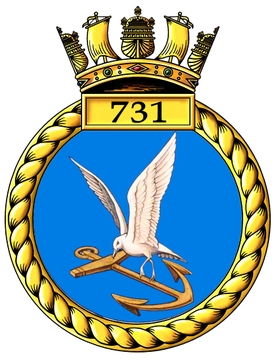
731 Naval Air Squadron was a Naval Air Squadron of the Royal Navy's Fleet Air Arm (FAA). It was active between 1943 and 1945 and its sole role throughout its formation was a Deck Landing Control Officer training squadron. Through this role the squadron pilots were nicknamed 'Clockwork Mice'. It was based out of the purpose built airbase, commissioned as HMS Peewit, known as Royal Naval Air Station East Haven, in Scotland, as part of the Deck Landing Training School there.

733 Naval Air Squadron was a Naval Air Squadron of the Royal Navy's Fleet Air Arm. It was active between January 1944 and December 1947, entirely in Ceylon, as a Fleet Requirements Unit, based mainly at R.N. Air Section China Bay, which became HMS Bambara, RNAS Trincomalee, China Bay, Ceylon. The squadron initially formed at R.N. Air Section Minneriya, at RAF Minnerya, Ceylon, two weeks after an advance party arrived there, remaining for three months after formation before relocating.

759 Naval Air Squadron was a Naval Air Squadron of the Royal Navy's Fleet Air Arm. It was created on November 1, 1939, and was disbanded on December 24, 1969. It was initially intended as a Telegraphist Air Gunner Training Squadron but became a Fighter School and Pool Squadron in 1939, at RNAS Eastleigh. It operated out of RNAS Yeovilton from 1940 to 1946, as part of the Naval Air Fighter School. In 1943 a detachment operated out of RNAS Angle, working with 794 NAS and known as the Naval Air Firing Unit. It was again the Naval Air Fighter School upon reformation in 1951 and disbandment in 1954, firstly at RNAS Culdrose and then moving to RNAS Lossiemouth, in 1953. The squadron reformed again, this time at RNAS Brawdy in 1963, as the Naval Advanced Flying Training School, before finally disbanding in 1969.

766 Naval Air Squadron was a Naval Air Squadron of the Royal Navy's Fleet Air Arm. It was to have initially formed in 1939 at HMS Daedalus, RNAS Lee-on-Solent, as a Seaplane School, however, it formed at HMS Landrail, RNAS Machrihannish, as a Night ALT Course, in 1942. It moved to HMS Nightjar, RNAS Inskip, in 1943, to become part of No. 1 Naval Operational Training Unit. By 1944, it was operating over 30 Swordfish aircraft, but, during the year, also acquired Firefly aircraft from 1772 NAS, and Sea Hurricane aircraft from 760 NAS. It moved to HMS Merganser, RNAS Rattray, early in 1946, but later that year, moved to HMS Fulmar, RNAS Lossiemouth, where it received Seafire aircraft, along with being Part 1 of the Operational Flying School. By late 1951, Sea Fury trainer aircraft were also added to its varied list of types operated. In 1953, the squadron moved to HMS Seahawk, RNAS Culdrose, where it disbanded in 1954.

767 Naval Air Squadron was a Naval Air Squadron of the Royal Navy's Fleet Air Arm. It was initially formed as a Deck Landing Training Squadron in 1939, when 811 Naval Air Squadron was renumbered 767 Naval Air Squadron, at HMS Merlin, RNAS Donibristle. A detachment went to Hyeres de la Palyvestre in the south of France, enabling training in fairer conditions. While here, the squadron took on an operational mission, with a bombing attack on the Italian port of Genoa. With the fall of France the squadron evacuated to Algeria, where it split. Part went to Malta, forming 830 Naval Air Squadron, the other part to HMS Ark Royal, with personnel returning to the UK via Gibraltar. The squadron regrouped at HMS Condor, RNAS Arbroath, and moved to the Deck Landing School at HMS Peewit at RNAS East Haven in 1943.

768 Naval Air Squadron was a Naval Air Squadron of the Royal Navy's Fleet Air Arm (FAA). It last disbanded at HMS Gannet, RNAS Eglinton, Northern Ireland, in March 1949, having been formed as a Deck Landing Control Officer Training Squadron, in December 1948, to ensure one American-style signal trained DLCO could be located at every FAA station. It first formed as part of the Deck Landing Training School at HMS Condor, RNAS Arbroath, in January 1941, as a Deck Landing Training Squadron. Advanced training was in HMS Argus, for which a detachment was maintained at HMS Landrail, RNAS Machrihanish, where it wholly moved to in March 1943. September saw a move to RAF Heathfield, Ayr, followed by a further move to HMS Sanderling, RNAS Abbotsinch in January 1944. Training used escort carriers on the Firth of Clyde and a detachment was maintained at (Heathfield)Ayr throughout this period, with the squadron returning there in July 1945, at this time HMS Wagtail, RNAS Ayr. In August the squadron moved to HMS Corncrake, RNAS Ballyhalbert in Northern Ireland but then in October it joined up with the Deck Landing School at HMS Peewit, RNAS East Haven, Scotland, where it disbanded in April 1946.

772 Naval Air Squadron was a Naval Air Squadron of the Royal Navy's Fleet Air Arm which last disbanded during September 1995. 772 Naval Air Squadron formed as a Fleet Requirements Unit out of ‘Y’ Flight from 771 Naval Air Squadron at RNAS Lee-on-Solent in September 1939. While the headquarters remained there, floatplanes were operated out of RNAS Portland, however, mid 1940 saw the whole squadron move north to RNAS Campbeltown and roughly twelve months afterwards the short distance to RNAS Machrihanish. The unit moved to RNAS Ayr in July 1944 and became the Fleet Requirements Unit School. In January 1946 the squadron moved to RNAS Burscough in Lancashire, before moving to RNAS Anthorn in Cumberland, in May. It became the Northern Fleet Requirements Unit upon moving to RNAS Arbroath, in June 1947, but disbanded into 771 Naval Air Squadron in October. 772 Naval Air Squadron reformed as a Helicopter Support Squadron at RNAS Portland in September 1974. In September 1977 the squadron took over responsibility for a number of Ships' Flights of Royal Fleet Auxiliary ships. The squadron was used to reform 848 Naval Air Squadron for the Falklands Task Force in 1982, with the Ships' Flights absorbed into 847 Naval Air Squadron. In August 1982 it took on the Anti-Submarine Warfare Flight from 737 Naval Air Squadron and between 1983 - 1985 a Search and Rescue Flight operated out of RNAS Lee-on-Solent.

775 Naval Air Squadron was a Naval Air Squadron of the Royal Navy's Fleet Air Arm which last disbanded in March 1946. 775 Naval Air Squadron formed at HMS Grebe, RNAS Dekheila, during November 1940, as a Fleet Requirements Unit in support of the Mediterranean Fleet, based at Alexandria, Egypt. Between October 1941 and March 1942 the squadron also included the RN Fighter Flight. It absorbed 728 Naval Air Squadron in July 1943 and moved to R.N.Air Section Gibraltar at the start of February 1944. The squadron returned to HMS Grebe, RNAS Dekheila during August 1945.

777 Naval Air Squadron was a Naval Air Squadron of the Royal Navy's Fleet Air Arm, which formed as a Fleet Requirements Unit in West Africa during the Second World War. Throughout most of 1943, the squadron was responsible for the air defence of Sierra Leone. It disbanded at HMS Spurwing, RNAS Hastings, Sierra Leone, during December 1944. The squadron reformed in May 1945, from 'B' Flight of 778 Naval Air Squadron, as a Carrier Trials Unit operating aboard HMS Pretoria Castle, and using shore bases at HMS Siskin, RNAS Gosport, and HMS Peregrine, RNAS Ford in England, and HMS Wagtail, RNAS Ayr, in Scotland. 777 Naval Air Squadron number was assigned to the aircraft collection at the Fleet Air Arm Museum in April 2006.
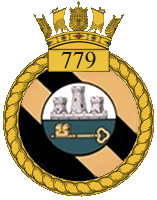
779 Naval Air Squadron was a Naval Air Squadron of the Royal Navy's Fleet Air Arm. Formed as a Fleet Requirements Unit, in October 1941, at R.N. Air Section Gibraltar. It operated a small variety of aircraft for target towing and coastal defence. In 1943, the squadron received some Bristol Beaufighter aircraft and a detachment of these deployed to Taranto, after which they also saw service at various airbases around North Africa. It disbanded, during August 1945, at Gibraltar.

787 Naval Air Squadron was a Naval Air Squadron of the Royal Navy's Fleet Air Arm which disbanded in January 1956. It formed in March 1941, at HMS Heron, RNAS Yeovilton, out of 804 Naval Air Squadron as a Fleet Fighter Development Unit. Almost every type of fighter was received by the squadron for testing and evaluation for naval use. A move to RAF Duxford in June 1941 saw it become the Naval Air Fighting Development Unit, attached to the Royal Air Force's Air Fighting Development Unit. The squadron undertook rocket projectile test, continuous development of fighter tactics and even helping Torpedo Bomber Reconnaissance squadrons in evading fighter attack. Post Second World War it continued its trials task and also undertook Rebecca radar trials and ASH, US-built air-to-surface vessel radar trials.

788 Naval Air Squadron was a Naval Air Squadron of the Royal Navy's Fleet Air Arm which last disbanded during June 1945. The squadron formed at RN Air Section China Bay in Ceylon, in January 1942, as the British Eastern Fleet's Torpedo Bomber Reconnaissance Pool, however it lost half its strength during the heavy raids by Japanese carrier-borne aircraft in the April. The squadron regrouped at RNAS Tanga in Tanganyika, East Africa to become a Fleet Requirements Unit and relocating almost immediately to RN Air Section Port Reitz, in Mombasa, where it remained operational for the next three years.

789 Naval Air Squadron was a Naval Air Squadron of the Royal Navy's Fleet Air Arm which disbanded in November 1945. 789 Naval Air Squadron formed as a Fleet Requirements Unit at RNARY Wingfield in South Africa, at the beginning of July 1942. It initially only had a single Supermarine Walrus, needing to borrow other aircraft types. 1943 saw the squadron sharing and holding aircraft for other Fleet Air Arm units and it wasn’t until 1944 it started to receive a notable number of its own aircraft.

797 Naval Air Squadron was a Naval Air Squadron of the Royal Navy's Fleet Air Arm which last disbanded in October 1945 in Ceylon. Its role was a Fleet Requirements Unit which formed at HMS Ukussa, Royal Naval Air Station Katukurunda, in Ceylon, in July 1942. The squadron moved to RNAS Colombo Racecourse in October 1943. It had a Communications Flight which became 742 Naval Air Squadron in December 1943 and the following summer it had an ‘X’ Flight deployed for target towing for a couple of gunnery schools in Bombay, India and which eventually moved to 722 Naval Air Squadron.

Royal Naval Air Station Twatt, is a former Royal Navy Air Station located near Twatt, Orkney, Scotland. It was built by the Admiralty and was commissioned on 1 April 1941. On 1 January 1942 it became an independent command as HMS Tern. The airbase was designed to provide accommodation for disembarked Front-Line squadrons and accommodation for disembarked Ship's Flight Aircraft and was home to the Home Fleet Fleet Requirements Unit, 771 Naval Air Squadron.
Over 700 different aircraft models were used during World War II. At least 135 of these models were developed for naval use, including about 50 fighters and 38 bombers.
